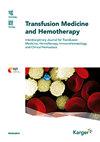从COVID-19恢复的传统献血者的细胞因子、抗sars - cov -2抗体和中和抗体水平
IF 1.9
4区 医学
Q3 HEMATOLOGY
引用次数: 0
摘要
& lt; b> & lt; i>背景:& lt; / i> & lt; / b>在大流行开始时,含有抗sars - cov -2抗体的COVID-19恢复期血浆(CCP)被建议作为一种治疗来源。在过去的3年中,许多试验表明CCP治疗的有效性有限。这导致我们假设CCP可能包含其他元素,以及所需的中和抗体,这些元素可能潜在地阻止其发挥治疗作用,其中包括细胞因子,趋化因子,生长因子,凝血因子和自身抗体。& lt; b> & lt; i>方法:& lt; / i> & lt; / b>总共分析了190名献血者血浆中的39种细胞因子,并进一步研究了CCP中23种不同细胞因子(sCD40L、eotaxin、FGF-2、FLT-3L、ractalkine、GRO-α、IFNα2、IL-1β、IL-1RA、IL-5、IL-6、IL-8、IL-12、IL-13、IL-15、IL-17E、IP-10、MCP-1、MIP-1b、PDGF-AA、TGFα、TNFα和TRAIL)的水平。CCP检测到抗sars - cov -2抗体和中和抗体。& lt; b> & lt; i>结果:& lt; / i> & lt; / b>我们发现,在首次出现COVID-19症状后最多180天内服用CCP与对照组之间没有显著差异。我们还比较了低中和抗体(<160)组和高中和抗体(≥160)组之间的细胞因子水平,发现两组之间没有差异。我们的研究还显示,与抗sars - cov -2 IgG Ab水平或中和抗体水平均无相关性。在COVID-19症状开始后的时间内,细胞因子水平也没有显著变化。& lt; b> & lt; i>结论:& lt; / i> & lt; / b>没有发现任何可能阻止CCP产生治疗效果的因素。本文章由计算机程序翻译,如有差异,请以英文原文为准。
Cytokine, Anti-SARS-CoV-2 Antibody, and Neutralizing Antibody Levels in Conventional Blood Donors Who Have Recovered from COVID-19
Background: At the beginning of the pandemic, COVID-19 convalescent plasma (CCP) containing anti-SARS-CoV-2 antibodies was suggested as a source of therapy. In the last 3 years, many trials have demonstrated the limited usefulness of CCP therapy. This led us to the hypothesis that CCP could contain other elements, along with the desired neutralizing antibodies, which could potentially prevent it from having a therapeutic effect, among them cytokines, chemokines, growth factors, clotting factors, and autoantibodies. Methods: In total, 39 cytokines were analyzed in the plasma of 190 blood donors, and further research focused on the levels of 23 different cytokines in CCP (sCD40L, eotaxin, FGF-2, FLT-3L, ractalkine, GRO-α, IFNα2, IL-1β, IL-1RA, IL-5, IL-6, IL-8, IL-12, IL-13, IL-15, IL-17E, IP-10, MCP-1, MIP-1b, PDGF-AA, TGFα, TNFα, and TRAIL). Anti-SARS-CoV-2 antibodies and neutralizing antibodies were detected in CCP. Results: We found no significant differences between CCP taken within a maximum of 180 days from the onset of the first COVID-19 symptoms and the controls. We also made a comparison of the cytokine levels between the low neutralizing antibodies (<160) group and the high neutralizing antibodies (≥160) group and found there were no differences between the groups. Our research also showed no correlation either to levels of anti-SARS-CoV-2 IgG Ab or to the levels of neutralizing antibodies. There were also no significant changes in cytokine levels based on the period after the start of COVID-19 symptoms. Conclusions: No elements which could potentially be responsible for preventing CCP from having a therapeutic effect were found.
求助全文
通过发布文献求助,成功后即可免费获取论文全文。
去求助
来源期刊
CiteScore
4.00
自引率
9.10%
发文量
47
审稿时长
6-12 weeks
期刊介绍:
This journal is devoted to all areas of transfusion medicine. These include the quality and security of blood products, therapy with blood components and plasma derivatives, transfusion-related questions in transplantation, stem cell manipulation, therapeutic and diagnostic problems of homeostasis, immuno-hematological investigations, and legal aspects of the production of blood products as well as hemotherapy. Both comprehensive reviews and primary publications that detail the newest work in transfusion medicine and hemotherapy promote the international exchange of knowledge within these disciplines. Consistent with this goal, continuing clinical education is also specifically addressed.

 求助内容:
求助内容: 应助结果提醒方式:
应助结果提醒方式:


